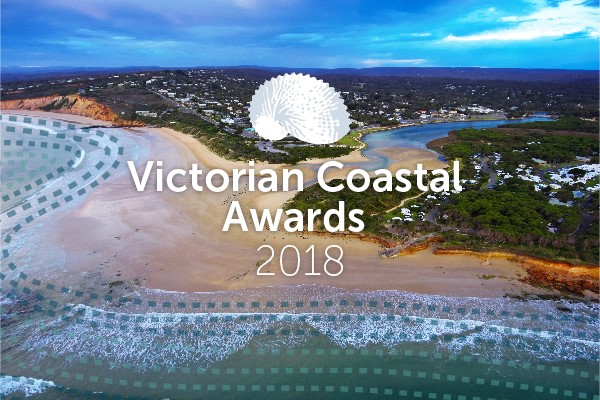
The Awards celebrate the efforts of Victorians in protecting and enhancing coastal and marine environments.
Over 220 guests from volunteer groups, committees of management, non-governmental organisations and state agencies attended the Awards ceremony at Encore in St Kilda. Guests were welcomed to country by Wurundjeri Elder Perry Wandin and Bunurong Elder Shane Clark, with the Hon. Lily D’Ambrosio, Minister for Energy Environment and Climate Change, presenting the trophies to this year’s winners.
This year’s Awards attracted 55 diverse and impressive nominations in the 7 Award categories. The Council was thrilled to see so many deserving candidates receive formal recognition for their incredible dedication.
The final Award of the evening was presented to Marg O’Toole in the ‘Outstanding Individual Achievement’ category. Marg has been involved in coastal and marine research, planning, management and environmental education in Victoria for over 25 years, and continues to share her extraordinary passion and knowledge to deliver significant and lasting outcomes for the Victorian coast.
2018 Award Winners
Kingston City Council - Mordialloc Life Saving Club and Aboriginal Gathering Place
Kingston City Council - Mordialloc Life Saving Club and Aboriginal Gathering Place
Mordialloc Life Saving Club has a long history in the City of Kingston, with the original Club forming in 1919. Facilities were aging and could no longer adequately serve the growing Club and broader community. A new state of the art facility was developed, replacing the existing facility, and providing multiple benefits to the local community and visitors. The new Mordialloc Life Saving Club and Aboriginal Gathering Place features:
- A Life Saving Club – providing important aquatic safety, training and education programs.
- A recreational space – supporting the Life Saving Club’s engagement with the wider community, and delivery of a broader range of programs.
- An Aboriginal Gathering Place – a permanent base for the Kingston Koorie Mob, an indigenous youth group, who have not previously had a meeting place.
The new Gathering Place offers the Kingston Koorie Mob a sense of belonging and community. It is designed to be a place of welcome for Aboriginal community members where they can connect, build skills, learn from Aboriginal Elders and Traditional Owners, share cultural heritage and hear about local cultural history.
The facility is also a resource for the broader Kingston community to learn about Aboriginal culture, promote Aboriginal cultural heritage and strengthen community connections and connections to Traditional Owners.
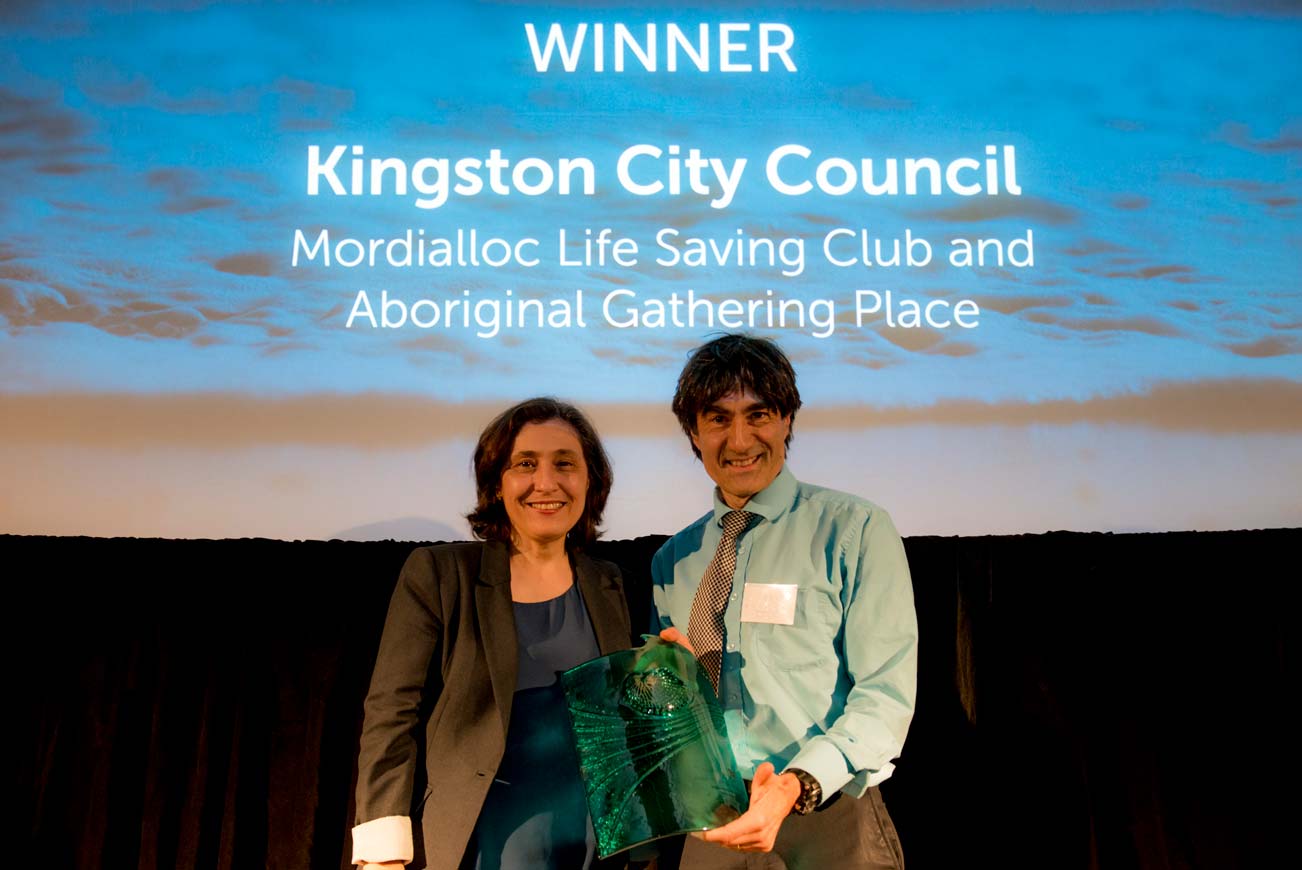
Gippsland Ports - Gippsland Lakes Migratory and Shore Bird Habitat Restoration
The Gippsland Lakes are home to hundreds of species of migratory and resident waterbirds, seabirds and shorebirds. The area is listed under the Ramsar Convention on Wetlands of International Importance, and many of the feathered visitors are protected by international migratory bird agreements. Annually, more than 20 species of migratory waders visit the Gippsland Lakes to feed, rest and breed. Crescent Island, Pelican Island and nearby sand spits provide critical habitat and refuge for hundreds of bird species, including Victoria largest active Pelican rookery.
Over the past decade, erosion, destabilisation and flooding have diminished these habitats considerably, impacting breeding activity and survival. The nearby channels to Crescent Island and Pelican Island were also due for dredging works as part of Gippsland Ports commitment to safe and navigable channels for recreational boating.
This led to a unique collaboration between natural resource managers, waterway managers and community volunteers.
Gippsland Ports needed to shift a great deal of sand and the birds needed sand! Critical habitat was created, and safer, more accessible waterways were provided for boaters, resulting in observation of breeding for many species including Fairy Terns, Little Terns, the threatened Hooded Plovers, and 10 species of Northern Hemisphere waders recorded feeding, foraging and roosting on the newly created island habitat, along with large numbers of swans, pelicans and shorebirds sighted on the islands.
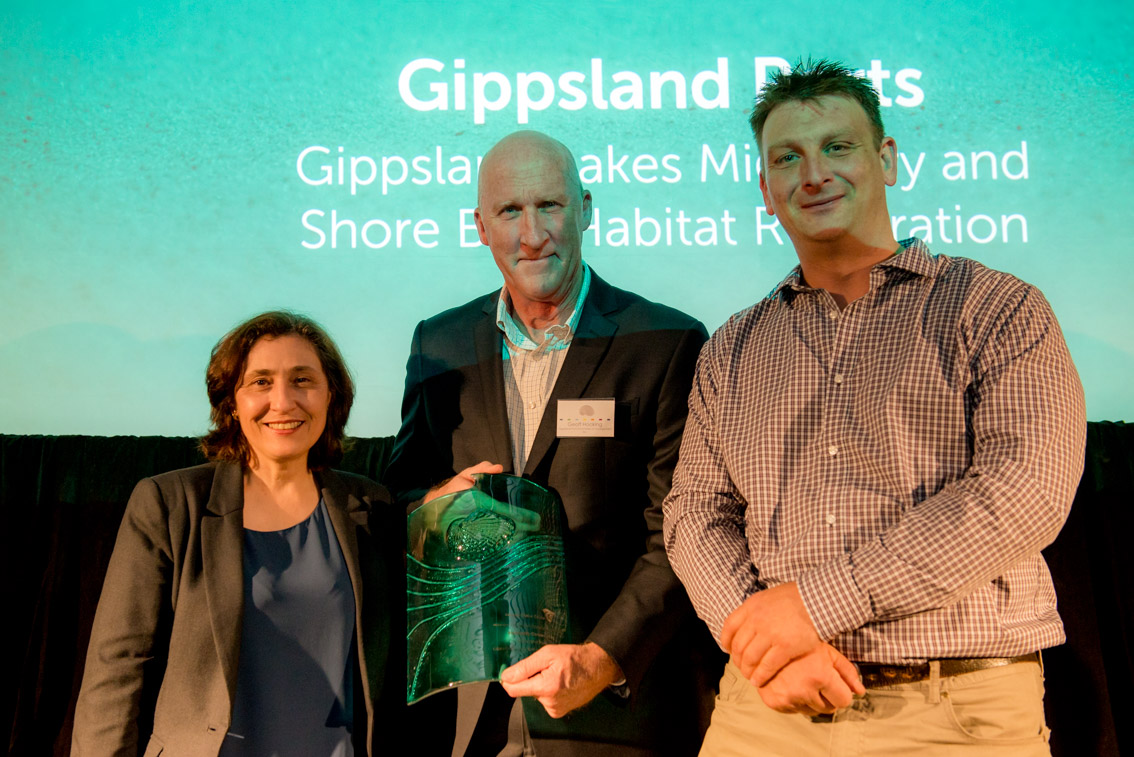
Project Banjo Action Group, Victorian Fisheries Authority, FutureFish, Boating Industry Association Victoria, Fishcare - Safeguarding Stingrays
Project Banjo Action Group, Victorian Fisheries Authority, FutureFish, Boating Industry Association Victoria, Fishcare - Safeguarding Stingrays
Large rays are iconic residents and local identities at many piers and jetties in Port Phillip Bay. These animals are much loved and highly regarded by locals, tourists, divers, snorkelers and many fishers.
In recent years, these marine creatures along with many harmless, smaller fiddler rays (‘Banjos’) have been found injured or dead beneath the piers. Of concern was the common but illegal practice of injuring and discarding the rays beneath the piers, often with their wings removed.
Project Banjo Action Group swung into action, lobbying for changes to legislation, education, enforcement and signage. Through careful, collaborative engagement the Group partnered with the Victorian Fisheries Authority, FutureFish, the Boating Industry Association Victoria and Fishcare to consult with recreational fishers, environment stakeholders and the community across the Victoria.
Project Banjo Action Group initiated a high-profile community conversation via social and print media, radio and an online petition that attracted 33,000 signatures. Social media was the primary avenue for information sharing and engagement, enabling messages to spread quickly and widely, from local residents, divers and anglers through to national and international individuals and interest groups. The Victorian Fisheries Authority’s public consultation on proposed new ray fishing rules received 1,200 submissions from across Victoria, interstate and some internationally, the vast majority supporting increased protection.
As a result, the new rules were introduced, providing increased protection for rays across Victoria’s marine waters especially around the piers, jetties and breakwaters Victoria’s stingrays, with practical education and enforcement solutions in place.
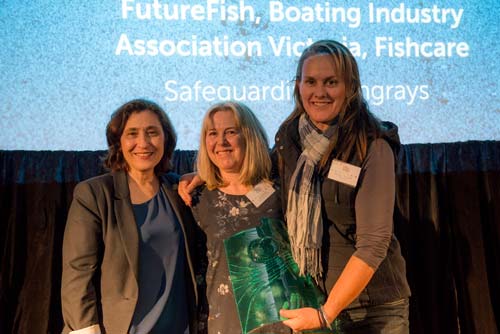
Great Ocean Road Coast Committee - Great Ocean Road Coastal Education – the next generation of coastal protectors
The Great Ocean Road coastal environment is threatened by erosion, rubbish, weeds, lack of biodiversity, and increasing population pressures. The Great Ocean Road Coast Committee believe that education is the key to sustaining this iconic coastline, and since 2010 have been conducting free activities to engage people from all over Victoria in hands on coastal natural resource management and conservation.
This successful, highly regarded education program promotes lifelong stewardship of the coast, fostering a culture of environmental advocacy and action through partnerships with local and visiting schools, agencies, campers and broader community.
As a self-financing, not-for-profit organisation, these educations programs are funded by the Great Ocean Road Coast Committee’s commercial operations, which include caravan parks at Anglesea, Torquay and Lorne. In 2016-17, Great Ocean Road Coast invested $275,000 in its free environment and education programs, with no shortage of schools wanting to become involved. The Program has grown significantly, delivering sessions for a range of ages, topics, curriculum outcomes and audiences.
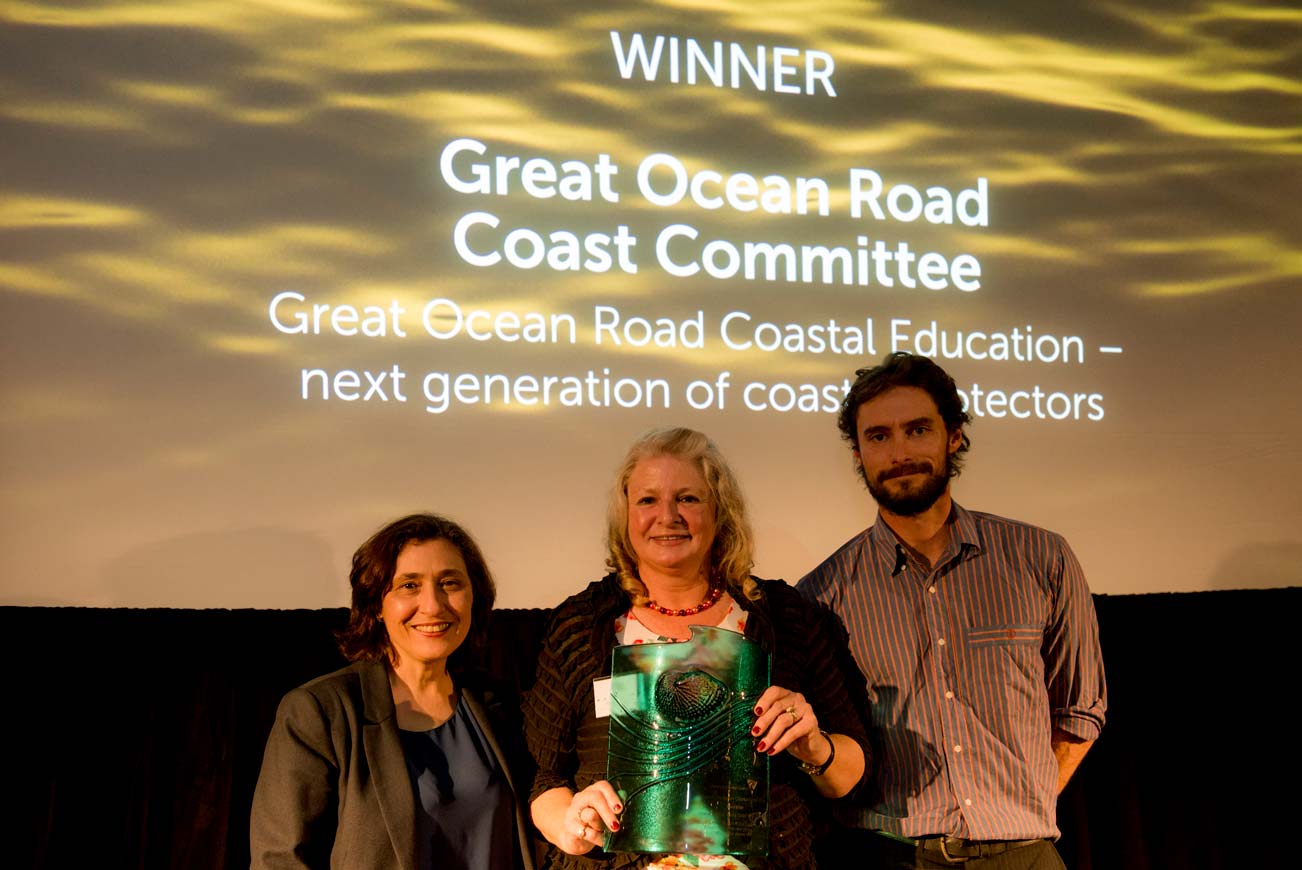
EstuaryWatch Victoria
EstuaryWatch Victoria is a citizen science program supporting community monitoring of estuary health. It is fast becoming a global leader in collecting, storing and communicating long term data sets in estuary condition.
Victoria’s 18 EstuaryWatch groups undertake monitoring, gathering estuary condition data and information to inform waterway managers and the community. 6731 observations have been submitted to the EstuaryWatch Victoria data portal (www.estuarywatch.org.au).
The data portal provides information on the latest water quality results, if an estuary is open or closed to the sea. It includes a photographic library of the estuary mouth status, and records of significant estuarine events such as fish deaths, storm surges, algae blooms and floods. EstuaryWatch data has been used by scientists and estuary managers to inform decision making and scientific research.
EstuaryWatch Victoria has earned a reputation amongst government agencies, researchers and coastal communities as a trusted source of information on the condition of Victoria’s estuaries and its volunteers are knowledgeable advocates for local estuaries.
In 2017 EstuaryWatch celebrated its 10th birthday, with key volunteers recognised for 10 years of service. Each EstuaryWatch group is supported by Coordinators based at Melbourne Water and the Glenelg Hopkins, Corangamite and West Gippsland Catchment Management Authorities.
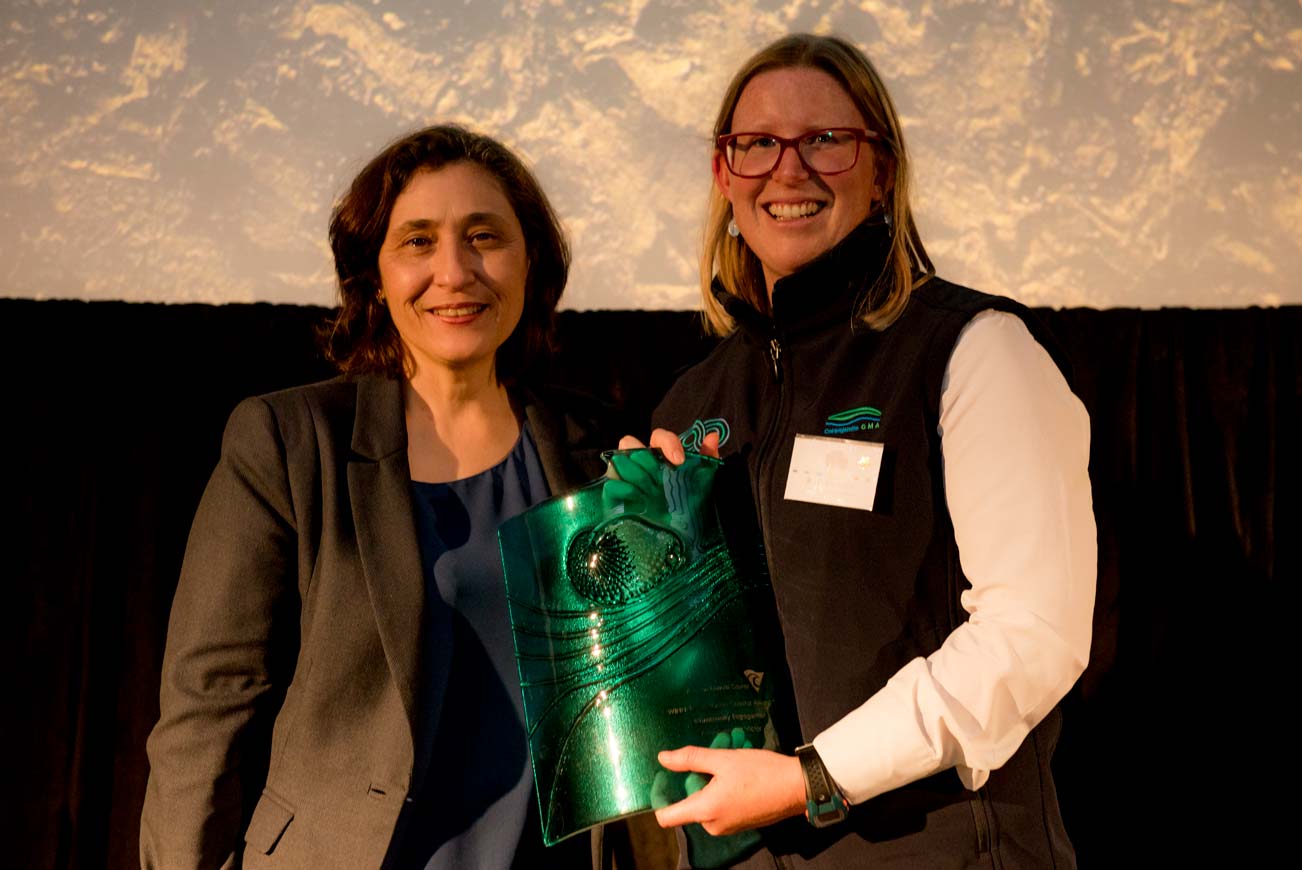
Deakin University, Parks Victoria, The University of Melbourne - Victorian Marine Park Habitat Mapping and Monitoring
Marine national parks are crucial environments and management tools for the protection of biodiversity, endangered and commercially valuable species. They also underpin coastal tourism.
The Victorian Marine Park Habitat Mapping and Monitoring Program is a state-of-the-art collaboration between Parks Victoria, Deakin and Melbourne Universities. It was established in response to the lack of fundamental baseline information, inhibiting the ability to sustainably manage marine national parks.
The team used unmanned aerial vehicles, high resolution multibeam sonar and new methods of subtidal reef surveys with towed video and stereo baited cameras. The team also secured Victoria’s first deployment of autonomous underwater vehicles as part of the International Marine Observation Network monitoring program.
The data provides an unparalleled understanding of Victoria’s open-coast marine park habitats. It includes 6000 square kilometres of seafloor mapping that has been exemplary in filling major knowledge gaps in marine national parks at Wilsons Promontory, Bunurong and Port Phillip Heads, informing biodiversity monitoring and fisheries assessment.
The project team has made many scientific advances of global impact, placing Victoria at the forefront of marine habitat science. The project has provided Victoria with a completely new understanding of its marine parks, habitat links and the process dynamics of these critical marine environments.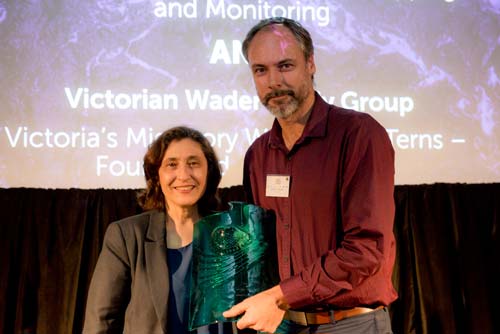
Victorian Wader Study Group - Victoria’s Migratory Waders and Terns – Four decades of research
For 40 years the Victorian Wader Study Group has conducted high quality, long-term scientific research on international migration routes, annual breeding success, population monitoring and the ecology of many migratory waders and key resident species like oystercatchers and crested terns.
Results are published in the annual Victorian Wader Study Group Bulletin. The data has been used to guide management planning for coastal areas and formed the basis of hundreds of scientific papers.
Through an extensive program of capture, banding, electronic tracking, flagging and release, volunteers have contributed an astonishing 14,000+ hours annually across coastal wetlands of Victoria, South Australia and King Island. Victorian catch sites extend from Port Fairy to the Gippsland Lakes, with regular catches around Port Phillip and Western Port bays, Andersons and Corner inlets.
The Group’s long-term dedication to research and publication, its co-operative working relationships with land managers and international peers, represent citizen science at its best.
Initially, the driver was to understand where the birds migrated to and what routes they took. Now there is a critical need to better understand and define the link between wader populations and changes in flyway habitat, from Victoria’s coast to their breeding grounds in the Arctic. The principal aim of the Victorian Wader Study Group is to gather, through extensive planned fieldwork programs. Our role, as users of the coast, is to ensure there is no deterioration of the sites that are essential for the birds during their austral summer visits.
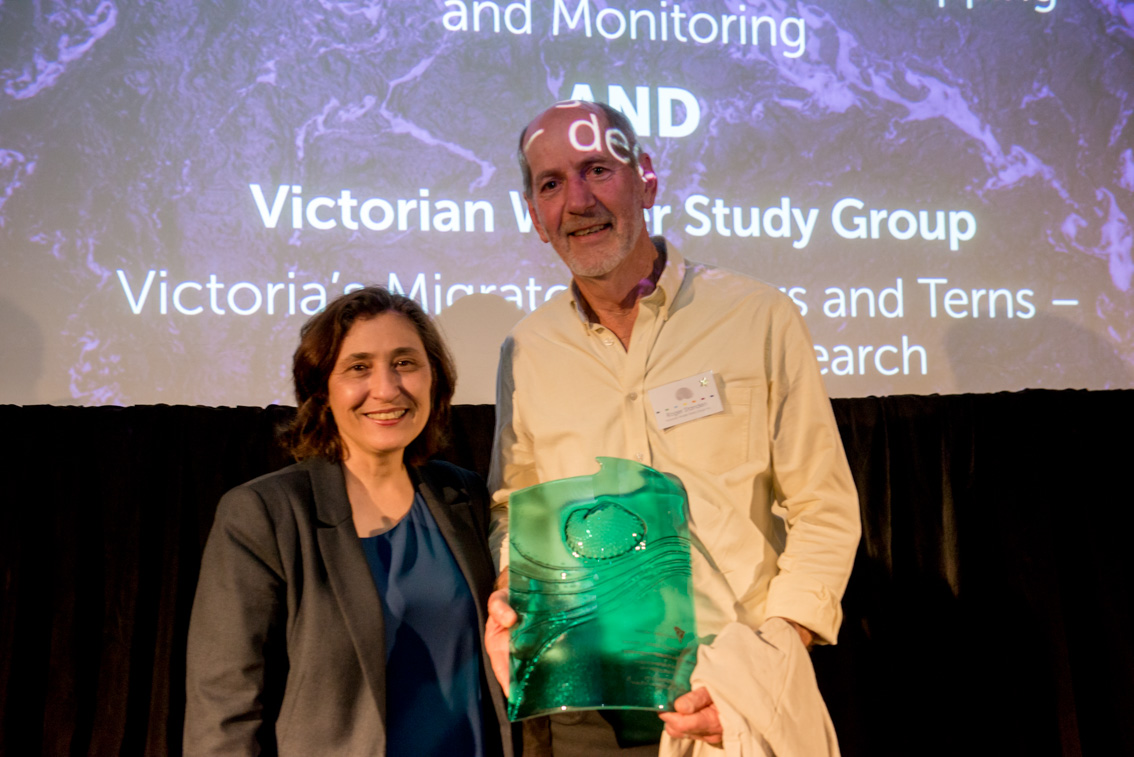
Marg O' Toole
Marg O’Toole has been a key contributor to coastal and marine research, planning, management and environmental education in Victoria for over 25 years. Marg has produced marine reference books, lectured on marine science and contributed widely to marine research. She has worked as a marine ranger and runs her own environmental interpretation and education business, all while working part time as a registered nurse specialising in paediatric care.
Marg O’Toole is an outstanding community leader, and active member of many coastal and marine boards, groups and community organisations.
A motivator, Marg gets environmental education programs up and running. She has been involved in Coastcare and Summer by the Sea in Victoria since inception, organising and running environmental activities, workshops and forums.
Marg has inspired and empowered people of all ages and walks of life to take an interest in their coastal and marine environment. She has devoted many hours of her spare time educating thousands of students (university, school, pre-school) and adults (volunteers, parents, teachers, land managers, divers), teaching, inspiring and empowering them to care about their coastal and marine environment. Every session she has led over the years has been of an exceptional standard with nothing but rave reviews.
Marg has a lifetime of marine and coastal experience, drawing on her extensive diving experience across eastern Australia and the south Pacific, and aquatic science studies through Deakin University. Marg is a go-to for marine educators statewide, generous with her ideas, information and encouragement. Feedback from any event where she is a speaker, presenter or participant is that not only is she a gifted communicator, but her passion for the marine environment is contagious. Marg continues to share her extraordinary passion and knowledge, delivering significant lasting outcomes for the Victorian coast and its communities.
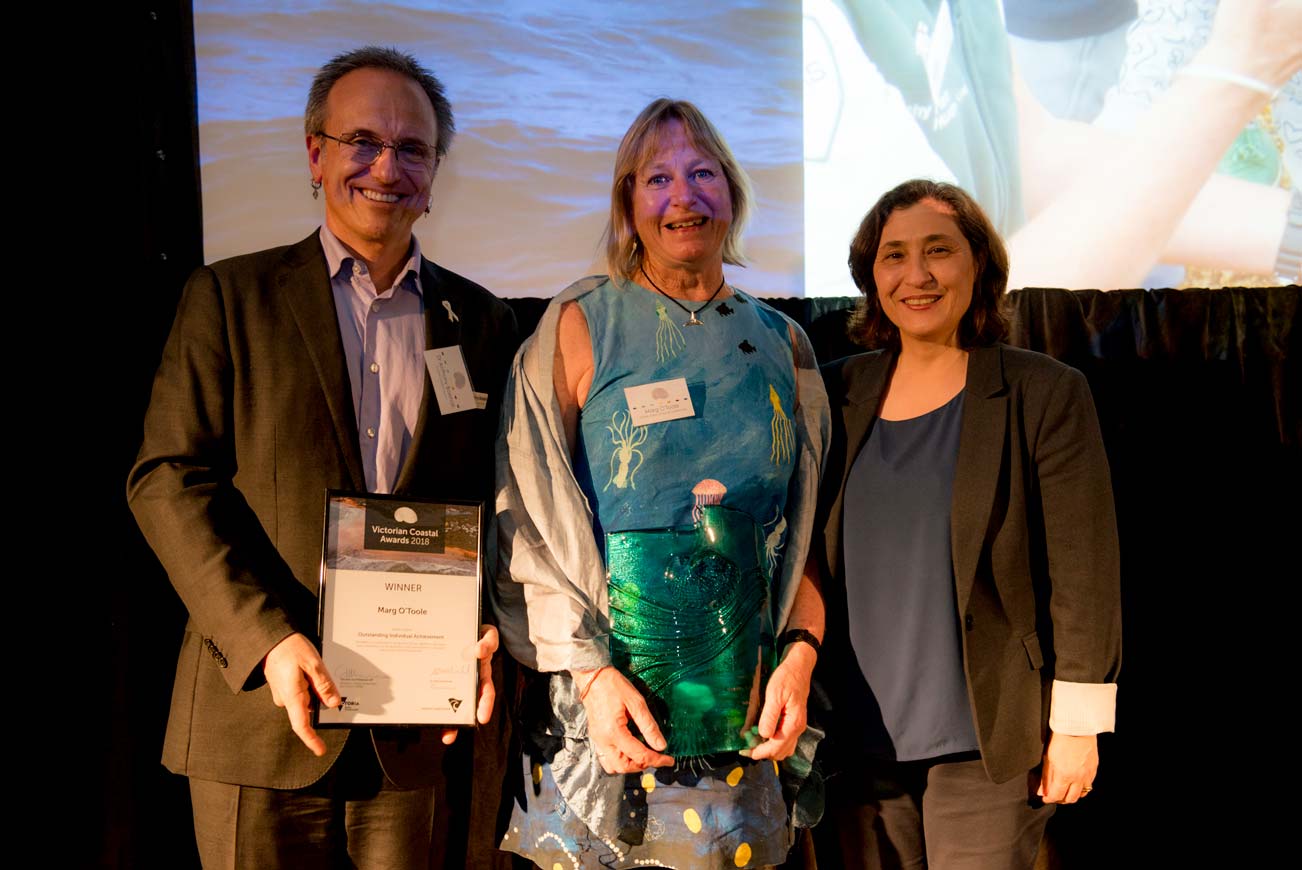
Page last updated: 15/11/22